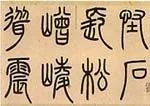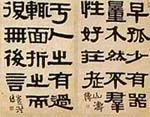Matt Stone
Master of Arts
I did a search on Google for Dong Koo Yudo Kwon.
Nothing.
I did another search on Google for Dong Koo Yudo Kwan.
Nearly nothing.
All that came up were hits for that title used in the biographies of tons of folks who are also members of Soke or Grandmaster organizations, and who all seem to possess multiple high grade rankings...
It is based in South Korea, and seems (at first glance) to be less than reputable...
This is an example of the bios I found:
Doctor of Martial Science
American College of Martial Science of The University of Indiana, Ph.D (honorary)-Martial Arts Philosophy.
Lifetime Member, International Combat Martial Arts Doctors and Scientists Union ICMAUA
Registered TKD Dan Holder with the Kukkiwon-Seoul, Korea
8th Dan Recognition & Registration, World Soke Head Council Headquarters, Kobe, Japan
8th Dan Dong-Koo Yudo Kwan, (KYA) - Seoul, Korea
8th Dan Ildokwan, World Ildokwan Federation-UK
8th Dan Taekwondo, Independedent Martial Arts Federation-USA (IMAF)
8th Dan Taekwondo, White Dragon Federation-Denmark
8th Dan Founder of Taeken-Jitsu, World Jug-Tai Head Founders Society- Arta, Greece
8th Dan Taeken-Jitsu, Drougas World Traditional Martial Arts-Greece
8th Dan Founder of Taeken-Jitsu, International Assembly of Sokeship, Founders & Headmasters
8th Dan Taeken-Jitsu, Founder, Head Instructor, Head Examiner, International Combat Martial Arts Founders Union ICMAUA
8th Dan Sung Ja Do (honorary), International Sung Ja Do Assn.-USA
8th Dan Taekwondo, Instructor, Examiner, International Combat Taekwondo Union ICMAUA
8th Dan Ildokwan, Instructor, Examiner, International Combat Taekwondo Union ICMAUA
8th Dan Ildokwan, Instructor, Examiner, International Combat Korean Martial Arts Union ICMAUA
8th Dan Dong-Koo Yudo Kwan, Instructor, Examiner, International Combat Korean Martial Arts Union ICMAUA
7th Dan Karate-Do (honorary), United Martial Arts Federation.
7th Dan Karate-Do, Instructor, Examiner, International Combat Karate Do Union ICMAUA.
4th Dan Jiu-Jitsu, The Black Arts Society (Canada) & IMAF
4th Dan Unarmed Military Combat, The Black Arts Society (Canada) & IMAF
4th Dan Unarmed Military Combat, Instructor, Examiner, International Combat Military Martial Arts Union ICMAUA
4th Dan Tsung Chen Do, The Tsung Chen Do Assn.-USA
4th Dan Tsung Chen Do, Instructor, Examiner, International Combat Martial Arts Union ICMAUA
4th Dan Jiu-Jitsu, Instructor, Examiner, International Combat Jujitsu Union ICMAUA
3rd Dan Moo Duk Kwan, The Korea TKD Moo Duk Hae-Seoul, Korea
3rd Dan Dragon Kenpo Karate, Dragon Kenpo Karate Assn.(USA) & IMAF
3rd Dan Dragon Kenpo Karate, Instructor, Examiner, International Combat Kenpo Union ICMAUA
3rd Dan Combat Taekwondo, The United States Combat Martial Arts Assn.
3rd Dan Combat Taekwondo, Instructor, Examiner, International Combat Taekwondo Union ICMAUA
3rd Dan Moo Duk Kwan, Instructor, Examiner, International Combat Taekwondo Union ICMAUA
1st Dan Hapkido, World Chontu Tae-Do Hapkido Fed. (Canada) & IMAF
1st Dan Hapkido, Instructor, Examiner, International Combat Hapkido Union ICMAUA
OTHER HONORS and POSITIONS:
Board of Directors, WWMAHOF & IMAF
Member of The World Ildokwan Federation Technical Advisory Council
Inducted into the World-Wide Martial Arts Hall of Fame (WWMAHOF)
Inducted into the Canada International Martial Arts Society Hall of Fame
Inducted into the World Il-Do-Kwan Federation International Hall of Fame -"Presidential Award for Dedicated Leadership'
Inducted into the International Combat Martial Arts Hall of Fame ICMAUA
Inducted into the International Combat Martial Arts Encyclopedia ICMAUA
Canada International Martial Arts Society-USA Representative
Registered International Master Instructor, World Ildokwan Federation
I wasn't aware someone could be ranked that highly in that many arts... :shrug:
Whatever.
Gambarimasu.
:asian:
Nothing.
I did another search on Google for Dong Koo Yudo Kwan.
Nearly nothing.
All that came up were hits for that title used in the biographies of tons of folks who are also members of Soke or Grandmaster organizations, and who all seem to possess multiple high grade rankings...
It is based in South Korea, and seems (at first glance) to be less than reputable...
This is an example of the bios I found:
Doctor of Martial Science
American College of Martial Science of The University of Indiana, Ph.D (honorary)-Martial Arts Philosophy.
Lifetime Member, International Combat Martial Arts Doctors and Scientists Union ICMAUA
Registered TKD Dan Holder with the Kukkiwon-Seoul, Korea
8th Dan Recognition & Registration, World Soke Head Council Headquarters, Kobe, Japan
8th Dan Dong-Koo Yudo Kwan, (KYA) - Seoul, Korea
8th Dan Ildokwan, World Ildokwan Federation-UK
8th Dan Taekwondo, Independedent Martial Arts Federation-USA (IMAF)
8th Dan Taekwondo, White Dragon Federation-Denmark
8th Dan Founder of Taeken-Jitsu, World Jug-Tai Head Founders Society- Arta, Greece
8th Dan Taeken-Jitsu, Drougas World Traditional Martial Arts-Greece
8th Dan Founder of Taeken-Jitsu, International Assembly of Sokeship, Founders & Headmasters
8th Dan Taeken-Jitsu, Founder, Head Instructor, Head Examiner, International Combat Martial Arts Founders Union ICMAUA
8th Dan Sung Ja Do (honorary), International Sung Ja Do Assn.-USA
8th Dan Taekwondo, Instructor, Examiner, International Combat Taekwondo Union ICMAUA
8th Dan Ildokwan, Instructor, Examiner, International Combat Taekwondo Union ICMAUA
8th Dan Ildokwan, Instructor, Examiner, International Combat Korean Martial Arts Union ICMAUA
8th Dan Dong-Koo Yudo Kwan, Instructor, Examiner, International Combat Korean Martial Arts Union ICMAUA
7th Dan Karate-Do (honorary), United Martial Arts Federation.
7th Dan Karate-Do, Instructor, Examiner, International Combat Karate Do Union ICMAUA.
4th Dan Jiu-Jitsu, The Black Arts Society (Canada) & IMAF
4th Dan Unarmed Military Combat, The Black Arts Society (Canada) & IMAF
4th Dan Unarmed Military Combat, Instructor, Examiner, International Combat Military Martial Arts Union ICMAUA
4th Dan Tsung Chen Do, The Tsung Chen Do Assn.-USA
4th Dan Tsung Chen Do, Instructor, Examiner, International Combat Martial Arts Union ICMAUA
4th Dan Jiu-Jitsu, Instructor, Examiner, International Combat Jujitsu Union ICMAUA
3rd Dan Moo Duk Kwan, The Korea TKD Moo Duk Hae-Seoul, Korea
3rd Dan Dragon Kenpo Karate, Dragon Kenpo Karate Assn.(USA) & IMAF
3rd Dan Dragon Kenpo Karate, Instructor, Examiner, International Combat Kenpo Union ICMAUA
3rd Dan Combat Taekwondo, The United States Combat Martial Arts Assn.
3rd Dan Combat Taekwondo, Instructor, Examiner, International Combat Taekwondo Union ICMAUA
3rd Dan Moo Duk Kwan, Instructor, Examiner, International Combat Taekwondo Union ICMAUA
1st Dan Hapkido, World Chontu Tae-Do Hapkido Fed. (Canada) & IMAF
1st Dan Hapkido, Instructor, Examiner, International Combat Hapkido Union ICMAUA
OTHER HONORS and POSITIONS:
Board of Directors, WWMAHOF & IMAF
Member of The World Ildokwan Federation Technical Advisory Council
Inducted into the World-Wide Martial Arts Hall of Fame (WWMAHOF)
Inducted into the Canada International Martial Arts Society Hall of Fame
Inducted into the World Il-Do-Kwan Federation International Hall of Fame -"Presidential Award for Dedicated Leadership'
Inducted into the International Combat Martial Arts Hall of Fame ICMAUA
Inducted into the International Combat Martial Arts Encyclopedia ICMAUA
Canada International Martial Arts Society-USA Representative
Registered International Master Instructor, World Ildokwan Federation
I wasn't aware someone could be ranked that highly in that many arts... :shrug:
Whatever.
Gambarimasu.
:asian:








